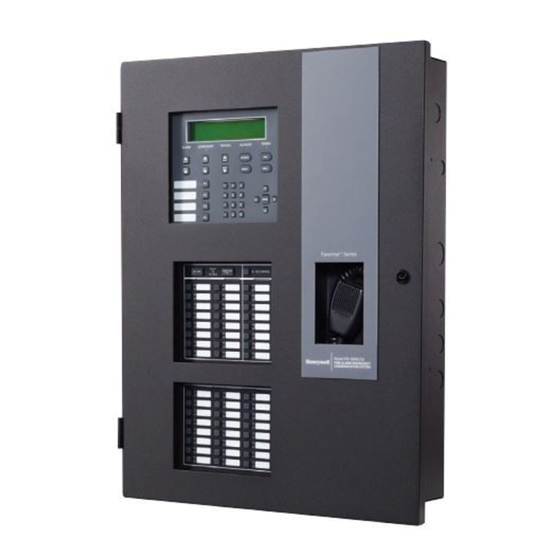
Honeywell Farenhyt Series Installation And Maintenance Instructions
Idp-photo, idp-photo-t and idp-acclimate intelligent photoelectric smoke sensors
Hide thumbs
Also See for Farenhyt Series:
- Installation and operation manual (212 pages) ,
- Manual (176 pages) ,
- Installation and maintenance instructions (4 pages)
Advertisement
Quick Links
INSTALLATION AND MAINTENANCE INSTRUCTIONS
Farenhyt™ Series
IDP-Photo, IDP-Photo-T and IDP-Acclimate
Intelligent Photoelectric Smoke Sensors
SPECIFICATIONS
Operating Voltage Range:
Standby Current:
Alarm Current (LED on):
Operating Humidity Range:
Operating Temperature Range:
Height:
Diameter:
Weight:
This sensor must be installed in compliance with the control panel system
installation manual. The installation must meet the requirements of the Au-
thority Having Jurisdiction (AHJ). Sensors offer maximum performance when
installed in compliance with the National Fire Protection Association (NFPA);
see NFPA 72.
GENERAL DESCRIPTION
Models IDP-Photo, IDP-Photo-T and IDP-Acclimate are plug-in type smoke
sensors that combine a photoelectronic sensing chamber with addressable-
analog communications. The sensors transmit an analog representation of
smoke density over a communication line to a control panel. Rotary dial
switches are provided for setting the sensor's address.
Two LEDs on the sensor are controlled by the panel to indicate sensor status.
An output is provided for connection to an optional remote LED annunciator
(P/N RA400Z/RA100Z). Models IDP-Acclimate and IDP-Photo-T combines a
photoelectronic sensing chamber and 135°F (57.2°C) fixed temperature heat
detector. The IDP-Acclimate also transmits an alarm signal due to heat (135°F
fixed) per UL 521.
Please refer to the operation manual for the UL listed control unit for specific
operation of the IDP-Photo, IDP-Photo-T and IDP-Acclimate.
The IDP-Photo, IDP-Photo-T and IDP-Acclimate require compatible address-
able communications to function properly. Connect these sensors to listed-
compatible control panels only.
SPACING
Honeywell recommends spacing sensors in compliance with NFPA 72. In low
air flow applications with smooth ceilings, space sensors 30 feet apart. When
using the IDP-Acclimate as a heat detector in FM3210 compliant applications,
space sensors 20 feet apart. For specific information regarding sensor spacing,
placement, and special applications, refer to NFPA 72.
Duct Applications: IDP-Photo and IDP-Photo-T are listed for use in ducts.
See Duct Applications Guide A05-1004 for details on pendant mount applications.
NOTE: IDP-PHOTO is listed for use inside DNR(W) duct smoke detectors.
WIRING GUIDE
All wiring must be installed in compliance with the National Electrical Code,
applicable local codes, and any special requirements of the Authority Having
Jurisdiction. Proper wire gauges should be used. The installation wires should
be color-coded to limit wiring mistakes and ease system troubleshooting. Im-
proper connections will prevent a system from responding properly in the
event of a fire.
Remove power from the communication line before installing sensors.
1.
Wire the sensor base (supplied separately) per the wiring diagram, Figure 1.
2.
Set the desired address on the sensor address switches, see Figure 2.
3.
Install the sensor into the sensor base. Push the sensor into the base
while turning it clockwise to secure it in place.
4.
After all sensors have been installed, apply power to the control unit and
activate the communication line.
5.
Test the sensor(s) as described in the TESTING section of this manual.
15 to 32 VDC
300µA @ 24 VDC Maximum
6.5 mA @ 24 VDC
10% to 93% Relative Humidity, Non-condensing
32°F to 120°F (0°C to 49°C), IDP-Photo; 32°F to 100°F (0°C to 38°C), IDP-Photo-T and IDP-Acclimate
2.0" (51mm) installed in B210LP Base
6.1" (155 mm) installed in B210LP Base; 4.1" (104 mm) installed in B501 Base
5.2 oz. (147 g)
12 Clintonville Road, Northford, CT 06472-1610
Dust covers provide limited protection against airborne dust particles during
shipping. Dust covers must be removed before the sensors can sense smoke.
Remove sensors prior to heavy remodeling or construction.
FIGURE 1. WIRING DIAGRAM:
REMOTE
ANNUNCIATOR
+
-
(+)
2
1
3
(–)
(–)
CLASS A OPTIONAL WIRING
(+)
FIGURE 2. ROTARY ADDRESS SWITCHES:
7
8
9
6
5
10
4
3
2
14
1 0
15
TENS
TAMPER-RESISTANCE
Models IDP-Photo, IDP-Photo-T and IDP-Acclimate include a tamper-resistant
capability that prevents their removal from the bracket without the use of a
tool. Refer to the base manual for details on making use of this capability.
TESTING
Before testing, notify the proper authorities that the system is undergoing
maintenance, and will temporarily be out of service. Disable the system to
prevent unwanted alarms.
All sensors must be tested after installation and periodically thereafter. Test-
ing methods must satisfy the Authority Having Jurisdiction (AHJ). Sensors
offer maximum performance when tested and maintained in compliance with
NFPA 72.
The sensor can be tested in the following ways:
A.
Functional: Magnet Test (P/N M02-04-01 or M02-09-00)
This sensor can be functionally tested with a test magnet. The test mag-
net electronically simulates smoke in the sensing chamber, testing the
sensor electronics and connections to the control panel.
1. Hold the test magnet in the magnet test area as shown in Figure 3.
1
Phone: 203-484-7161 Fax: 203-484-7118
www.Farenhyt.com
CAUTION
CAUTION: DO NOT LOOP WIRE
UNDER TERMINAL 1 OR 2.
BREAK WIRE RUN TO PROVIDE
SUPERVISION OF CONNECTIONS.
2
1
3
3
7
8
6
9
5
11
4
12
3
13
2
1 0
ONES
I56-3611-006
2
1
C0129-02
C0162-00
04-21
Advertisement

Summary of Contents for Honeywell Farenhyt Series
- Page 1 Connect these sensors to listed- compatible control panels only. SPACING Honeywell recommends spacing sensors in compliance with NFPA 72. In low air flow applications with smooth ceilings, space sensors 30 feet apart. When using the IDP-Acclimate as a heat detector in FM3210 compliant applications, space sensors 20 feet apart.
- Page 2 – Connect the equipment into an outlet on a circuit different from that to which the receiver is connected. – Consult the dealer or an experienced radio/TV technician for help. Farenhyt™ is a trademark of and Honeywell ® is a registered trademark of Honeywell International, Inc. I56-3611-006 ©2017 Honeywell. 04-21...












